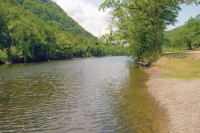Rooting out landslide prone slopes
As much as mountain dwellers take pride in the gnarled and weathered Rhododendron thickets that characterize Appalachian mountainsides, the signature bush could have a nasty side-effect.
The same uncanny knack of the twisted roots to cling to steep, rocky terrain also loosens the soil. The presence of rhododendron thickets could make a slope more prone to landslides during heavy rains, according to new research by U.S. Forest Service scientists at Coweeta Hydrological Laboratory in Macon County.
Triggered by heavy rainfalls, landslides have always been a lurking danger on steep slopes, often held at bay only by the network of tree roots.
“Roots of trees and shrubs can represent up to 100 percent of what’s holding soil together and keeping mountain slopes from sliding,” said Jim Vose, research ecologist and project leader at Coweeta.
The loss of trees due to development has sparked concern that more landslides could be on the horizon, further exacerbated by more frequent storms stemming from climate change.
Researchers got curious about which trees were more effective at holding soil in place.
Related Items
“For this study, we measured the root distribution and tensile strength — roughly, the force required to pull a root to the point where it breaks apart — of 15 Southern Appalachian species,” Vose said.
Among the line-up of oak, hemlock, birch, tulip poplar, hickory and other trees, all performed equally. Not so for the rhododendron, however, the one bush included in the test. Rhododendron has come to dominate the forest understory in some areas of the Southern Appalachians.
“We found that rhododendron had the shallowest, weakest roots suggesting that the recent expansion of this species may have lowered the cohesive strength of soil in some hollows,” said Vose.
Researchers compared tree root systems on different contours: namely concave depressions on the flank of a mountain known as hollows and the convex topography shaped like the back of a spoon. They found tree roots in hollows weren’t as strong and had less cellulose content, Vose said.
Researchers could then pinpoint exactly what mix of terrain and vegetation to watch out for.
“Since debris flows usually start in the hollows, those dominated by rhododendron could represent a heightened hazard for landslides,” Vose said.
Although the study was not designed to firmly establish cause and effect, the results suggest that rhododendron may be a key species affecting landslide initiation in the Southern Appalachians. The theory played out in 2004 when the region was battered by heavy rains from back-to-back tropical storms Frances and Ivan, triggering numerous landslides. Most started in rhododendron thickets, including the deadly Peeks Creek landslide in Macon County that claimed five lives and 15 homes.
The findings were published in JGR-Earth Surface by forest service researchers Chelcy Ford and Jim Vose, along with UNC-Chapel Hill researchers T.C. Hales and Larry Band.
The full text of the article can be found online at www.srs.fs.usda.gov/pubs/33547.









